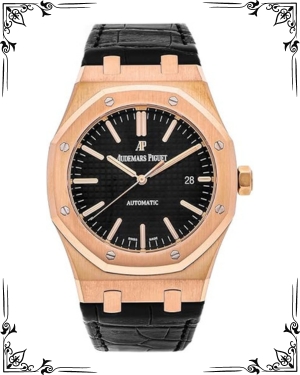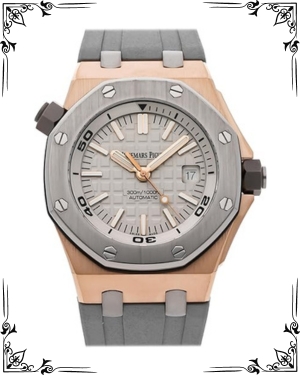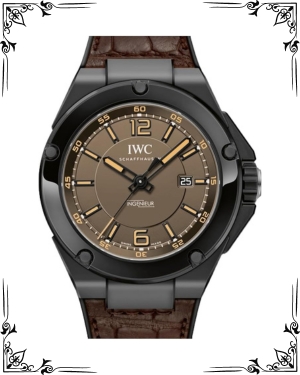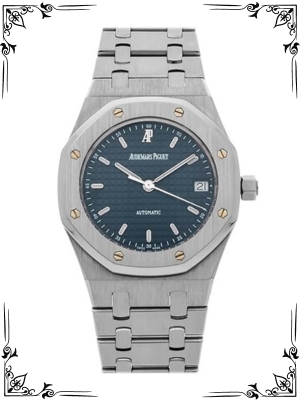The world of luxury sports watches boasts two titans: the iconic Audemars Piguet Royal Oak and the sophisticated IWC Ingenieur. Both represent innovation, prestige, and a commitment to excellence. But which one reigns supreme for you?
This comprehensive guide delves into the history, technical specifications, aesthetics, and brand image of these two remarkable timepieces. By the end, you’ll be well-equipped to choose the perfect luxury sports watch that complements your style and reflects your personality.
A Legacy of Time: Unveiling the History
Audemars Piguet Royal Oak (AP RO): Born in 1972 from the mind of legendary watch designer Gérald Genta, the Royal Oak shattered conventional expectations. Its bold case design, featuring an octagonal shape with exposed hexagonal screws, revolutionized the luxury sports watch category.
The use of stainless steel, a material previously reserved for tool watches, in a high-end timepiece was another groundbreaking decision. The Royal Oak quickly gained a reputation for its audacious design, robust construction, and exceptional craftsmanship.
IWC Ingenieur: Debuted in 1955, the Ingenieur established itself as a pioneer in anti-magnetic technology. Early Ingenieur models incorporated a soft iron inner cage to shield the delicate movement from the harmful effects of magnetic fields, a concern for scientists and engineers of the era.
Throughout its history, the Ingenieur has evolved, offering various styles and functionalities. However, it has maintained its core values of innovation, functionality, and a refined aesthetic that appeals to those who appreciate understated elegance.
While the Royal Oak disrupted the industry with its bold design, the Ingenieur carved a niche with its focus on technical innovation and practicality. Both watches hold a significant place in the history of luxury sports watches.
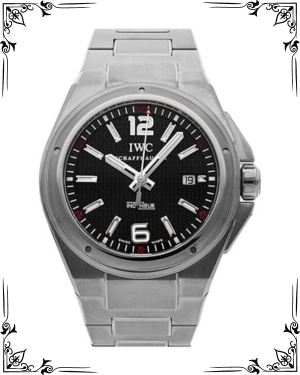
Under the Hood: A Technical Breakdown
Let’s delve deeper and compare the technical aspects of the AP Royal Oak and the IWC Ingenieur. Here, we’ll explore their movements, materials, and functionalities.
Movement
Audemars Piguet Royal Oak: Predominantly utilizes in-house manufactured automatic movements known for their precision and reliability. These movements boast impressive power reserves, typically ranging from 50 to 70 hours. Some high-end Royal Oak models might feature advanced complications like perpetual calendars or tourbillons.
IWC Ingenieur: Offers a wider variety of movement choices. Some models utilize in-house manufactured automatic movements known for their robustness and innovation. However, IWC also employs high-quality modified Sellita movements in some models, ensuring affordability without compromising on quality.
Power reserves typically range from 40 to 60 hours. While some Ingenieur models might offer complications like chronographs, the focus generally lies on functionality and clean design.
Materials and Construction
Case
Audemars Piguet Royal Oak: Renowned for its octagonal stainless steel case with a distinctive brushed finish and polished accents. The case features exposed hexagonal screws that are not only functional but also contribute to the watch’s bold aesthetic.
Case sizes range from 37mm to 44mm, catering to diverse preferences. Some Royal Oak models might utilize precious metals like rose gold or platinum for a more luxurious feel.
IWC Ingenieur: Offers a wider range of case materials and styles. Stainless steel is a popular choice, but some models utilize titanium for its lightweight properties or rose gold for a touch of elegance. Case sizes typically range from 40mm to 46mm.
While some Ingenieur models might feature an integrated bracelet design, others offer a more traditional case design with lugs for attaching straps. The overall construction emphasizes durability and comfort.
Bracelet:
Audemars Piguet Royal Oak: Features a signature integrated stainless steel bracelet with a brushed finish and polished accents. The bracelet is known for its robust construction and comfortable fit. Some models might offer alternative straps in rubber or leather for a more versatile look.
IWC Ingenieur: Offers more flexibility in terms of bracelets and straps. Many models come with a stainless steel bracelet featuring a brushed finish. However, IWC also offers a wide variety of high-quality leather straps and some models might even feature rubber straps for a sporty look. This allows you to personalize the look and feel of your Ingenieur.
Functions and Features:
Audemars Piguet Royal Oak: Offers a diverse range of functionalities, catering to various needs. The core models focus on time and date, but many variations exist.
These can include chronographs, GMT complications for displaying multiple time zones, date indicators, and even more complex features like moon phases or perpetual calendars in high-end models. The Royal Oak caters to those who seek a statement piece with a blend of luxury and functionality.
IWC Ingenieur: Generally prioritizes core functionalities like time, date, and power reserve. However, some models offer additional features like chronographs, automatic date functions, and anti-magnetic properties for those who work in environments with strong magnetic fields.
The Ingenieur leans towards a more understated approach, focusing on practicality and clean design. While some high-end Ingenieur models might offer complications like perpetual calendars, these are less common compared to the Royal Oak.
Water Resistance
Both the Royal Oak and Ingenieur offer impressive water resistance ratings, typically ranging from 100 meters to 300 meters. This makes them suitable for everyday wear, including swimming and even light diving (depending on the specific model).
A Matter of Style: Design and Aesthetics
Now, let’s explore the visual appeal of these two luxury sports watches.
Dial Design
Audemars Piguet Royal Oak: Features a distinctive tapisserie dial pattern, often in a rich blue or black color. The dial layout prioritizes clarity and legibility, with bold hands and luminous markers for excellent nighttime visibility. Some Royal Oak models might offer more complex dials with sub-dials for chronograph functions or additional complications.
IWC Ingenieur: Offers a wider variety of dial styles, reflecting the watch’s evolution throughout history. Some models feature a minimalist and functional design with clear markers and hands. Others might incorporate a more elegant and sophisticated aesthetic with Roman numerals or intricate details.
The Ingenieur dial generally prioritizes readability but can also offer a touch of understated luxury.
Brand Image:
Audemars Piguet Royal Oak: Cultivates an image of audacious design, innovation, and exclusivity. The Royal Oak is often associated with luxury, power, and a bold personality. Owning a Royal Oak signifies a taste for the unconventional and a desire to make a statement.
IWC Ingenieur: Embodies sophistication, functionality, and understated elegance. The Ingenieur appeals to those who appreciate quality craftsmanship, technical innovation, and a timeless design aesthetic. Owning an Ingenieur suggests a refined taste and an appreciation for practicality with a touch of luxury.
The Final Lap: Choosing Your Champion
So, which watch reigns supreme? Here’s a quick guide to help you decide:
Choose Audemars Piguet Royal Oak if:
- You prioritize a bold and distinctive design that makes a statement.
- You value in-house manufactured movements and appreciate cutting-edge technology.
- You seek a watch associated with luxury, exclusivity, and a touch of rebellion.
- You’re comfortable with a higher price point.
Choose IWC Ingenieur if:
- You appreciate a sophisticated and refined aesthetic with a timeless appeal.
- You value functionality, clean design, and anti-magnetic properties.
- You desire a watch associated with innovation, quality craftsmanship, and understated elegance.
- You prefer more versatility in terms of case materials, bracelets, and straps.
- You’re looking for a potentially more affordable option within the luxury sports watch category.
Conclusion
The Audemars Piguet Royal Oak and the IWC Ingenieur represent two distinct yet compelling approaches to luxury sports watches.
The Royal Oak pushes boundaries with its bold design and cutting-edge technology, while the Ingenieur offers a sophisticated blend of functionality, elegance, and a touch of history. Ultimately, the perfect choice boils down to your individual preferences.
Here are some additional tips to make your decision easier:
- Visit a reputable watch boutique and try on both the Royal Oak and Ingenieur models. This will allow you to experience the size, weight, and overall feel of each watch on your wrist.
- Consider your lifestyle: Do you require a watch with advanced features like a chronograph or GMT function? Or do you prioritize a clean and classic design?
- Set a budget: Luxury sports watches come at a premium price point. Knowing your budget will help you narrow down your options.
- Research-specific models: Both the Royal Oak and Ingenieur offer a wide range of variations. Research specific models that interest you to learn about their specific features, materials, and price points.
Remember, the ideal luxury sports watch is the one that resonates with you on a personal level. With the knowledge you’ve gained from this comprehensive guide, you’re well-equipped to choose the perfect Audemars Piguet Royal Oak or IWC Ingenieur that reflects your personality, complements your style, and becomes a cherished companion for years to come.
FAQs
What are the main differences in design between the IWC Ingenieur and the Audemars Piguet Royal Oak?
The IWC Ingenieur features a robust and technical design, often characterized by its integrated case and bracelet, and a distinct, industrial look. The Audemars Piguet Royal Oak, designed by Gérald Genta, is famous for its octagonal bezel with exposed screws, “tapisserie” patterned dial, and integrated bracelet, giving it a more elegant yet sporty appearance.
How do the movements differ between the IWC Ingenieur and the Audemars Piguet Royal Oak?
The IWC Ingenieur typically uses in-house movements, known for their durability and precision, such as the Caliber 80110 and Caliber 89361. The Audemars Piguet Royal Oak also features in-house movements, with the Caliber 2121 and Caliber 3120 being notable for their high level of finishing and intricate details, reflecting AP’s tradition of fine watchmaking.
Which watch offers better water resistance, the IWC Ingenieur or the Audemars Piguet Royal Oak?
The IWC Ingenieur generally offers better water resistance, often rated at 120 meters (394 feet), making it more suitable for swimming and snorkeling. The Audemars Piguet Royal Oak typically offers water resistance up to 50 meters (164 feet), which is adequate for everyday wear but less suited for water activities.
How do the materials used in the IWC Ingenieur compare to those in the Audemars Piguet Royal Oak?
Both the IWC Ingenieur and the Audemars Piguet Royal Oak use high-quality materials, including stainless steel, titanium, and precious metals like gold.
However, AP often incorporates more exotic materials and high-end finishes, such as forged carbon and ceramic, especially in its higher-end Royal Oak Offshore models, highlighting its position in the luxury watch segment.
What are the price ranges for the IWC Ingenieur and the Audemars Piguet Royal Oak?
The IWC Ingenieur is generally more affordable, with prices typically ranging from $5,000 to $15,000, depending on the model and complications.
The Audemars Piguet Royal Oak is positioned in the higher luxury segment, with prices starting around $20,000 and going well over $100,000 for more complicated or limited edition models, reflecting its status as a prestigious luxury watch.


